Comparison of Prophylactic Effects between Localized Biomimetic Minocycline and Systematic Amoxicillin on Implants Placed Immediately in Infected Sockets
Abstract
:1. Introduction
2. Materials and Methods
2.1. Subject Selection and Experimental Design
- (1)
- Group N—two uninfected mongrels.
- (2)
- Group P—two mongrels infected with oral bacterial culture.
- (3)
- Group A—two mongrels infected with oral bacterial culture and treated with amoxicillin orally administered 1 h before implant placement.
- (4)
- Group B—two mongrels infected with oral bacteria culture and treated with minocycline locally administered during implant placement.
- (5)
- Group C—two mongrels infected with oral bacteria culture and treated with amoxicillin orally administered 1 h before implant placement and with minocycline locally administered during implant placement.
- A total of 0.5 g of minocycline hydrochloride with HEC-glycerin microsphere carrier (Minoden dental ointment, Osstem Pharma, Seoul, Republic of Korea).
- A total of 500 mg of amoxicillin hydrate 1 h before implant placement via the oral route (Amoxis cap, Osstem Pharma). The dosage of amoxicillin was administered according to a previous study conducted with mongrels [15].
2.2. Infected Extraction Socket Model
2.3. Radiographic Bone Level
2.4. Removal Torque (RT)
2.5. Gingival Index (GI)
2.6. Probing Depth (PD)
2.7. Papillary Bleeding Index (PBI)
2.8. Statistical Analysis
3. Results
3.1. Radiographic Bone Level
3.2. RT
3.3. GI
3.4. PD
3.5. PBI
4. Discussion
5. Conclusions
- Systemic administration of amoxicillin before the implant placement in infected extraction sockets improved the implant success by preventing bone loss around the implant and by reducing inflammation of the peri-implant soft tissue.
- Localized application of biomimetic minocycline reduced radiographic bone loss and increased RT.
- Combined use of systemic amoxicillin and localized minocycline showed no augmented prophylactic effect, possibly due to their antagonistic interaction.
Author Contributions
Funding
Institutional Review Board Statement
Data Availability Statement
Conflicts of Interest
References
- Lazzara, R.J. Immediate implant placement into extraction sites: Surgical and restorative advantages. Int. J. Periodontics Restor. Dent. 1989, 9, 332–343. [Google Scholar]
- Casap, N.; Zeltser, C.; Wexler, A.; Tarazi, E.; Zeltser, R. Immediate placement of dental implants into debrided infected dentoalveolar sockets. J. Oral Maxillofac. Surg. 2007, 65, 384–392. [Google Scholar] [CrossRef] [PubMed]
- Werbitt, M.J.; Goldberg, P.V. The immediate implant: Bone preservation and bone regeneration. Int. J. Periodontics Restor. Dent. 1992, 12, 206–217. [Google Scholar]
- Quirynen, M.; Gijbels, F.; Jacobs, R. An infected jawbone site compromising successful osseointegration. Periodontol 2000 2003, 33, 129–144. [Google Scholar] [CrossRef] [PubMed]
- Barzilay, I. Immediate implants: Their current status. Int. J. Prosthodont. 1993, 6, 169–175. [Google Scholar] [PubMed]
- Adell, R.; Lekholm, U.; Rockler, B.; Branemark, P.I. A 15-year study of osseointegrated implants in the treatment of the edentulous jaw. Int. J. Oral Surg. 1981, 10, 387–416. [Google Scholar] [CrossRef] [PubMed]
- Roca-Millan, E.; Estrugo-Devesa, A.; Merlos, A.; Jane-Salas, E.; Vinuesa, T.; Lopez-Lopez, J. Systemic antibiotic prophylaxis to reduce early implant failure: A systematic review and meta-analysis. Antibiotics 2021, 10, 698. [Google Scholar] [CrossRef]
- Page, C.P.; Bohnen, J.M.; Fletcher, J.R.; McManus, A.T.; Solomkin, J.S.; Wittmann, D.H. Antimicrobial prophylaxis for surgical wounds. Guidelines for clinical care. Arch. Surg. 1993, 128, 79–88. [Google Scholar] [CrossRef]
- Peterson, L.J. Antibiotic prophylaxis against wound infections in oral and maxillofacial surgery. J. Oral Maxillofac. Surg. 1990, 48, 617–620. [Google Scholar] [CrossRef]
- Esposito, M.; Cannizzaro, G.; Bozzoli, P.; Checchi, L.; Ferri, V.; Landriani, S.; Leone, M.; Todisco, M.; Torchio, C.; Testori, T.; et al. Effectiveness of prophylactic antibiotics at placement of dental implants: A pragmatic multicentre placebo-controlled randomised clinical trial. Eur. J. Oral Implantol. 2010, 3, 135–143. [Google Scholar]
- Caiazzo, A.; Canullo, L.; Pesce, P. Consensus report by the Italian Academy of Osseointegration on the use of antibiotics and antiseptic agents in implant surgery. Int. J. Oral Maxillofac. Implant. 2021, 36, 103–105. [Google Scholar] [CrossRef] [PubMed]
- Lund, B.; Hultin, M.; Tranaeus, S.; Naimi-Akbar, A.; Klinge, B. Complex systematic review-Perioperative antibiotics in conjunction with dental implant placement. Clin. Oral Implant. Res. 2015, 26 (Suppl. S11), 1–14. [Google Scholar] [CrossRef] [PubMed]
- Klinge, B.; Flemming, T.; Cosyn, J.; De Bruyn, H.; Eisner, B.M.; Hultin, M.; Isidor, F.; Lang, N.P.; Lund, B.; Meyle, J.; et al. The patient undergoing implant therapy. Summary and consensus statements. The 4th EAO Consensus Conference 2015. Clin. Oral Implant. Res. 2015, 26 (Suppl. S11), 64–67. [Google Scholar] [CrossRef] [PubMed]
- Khatri, P.M.; Kumar, R. Use of minocycline as systemic antimicrobial therapy in refractory periodontitis with chronic gingival enlargement. J. Adv. Pharm. Technol. Res. 2012, 3, 75–79. [Google Scholar] [CrossRef] [PubMed]
- Sae-Lim, V.; Wang, C.; Trope, M. Effect of systemic tetracycline and amoxicillin on inflammatory root resorption of replanted dogs’ teeth. Dent. Traumatol. 1998, 14, 216–220. [Google Scholar] [CrossRef] [PubMed]
- Oz, H.S.; Puleo, D.A. Animal models for periodontal disease. BioMed Res. Int. 2011, 2011, 754857. [Google Scholar] [CrossRef] [PubMed]
- Marchesan, J.; Girnary, M.S.; Jing, L.; Miao, M.Z.; Zhang, S.; Sun, L.; Morelli, T.; Schoenfisch, M.H.; Inohara, N.; Offenbacher, S. An experimental murine model to study periodontitis. Nat. Protoc. 2018, 13, 2247–2267. [Google Scholar] [CrossRef]
- Johnson, K. A study of the dimensional changes occurring in the maxilla following tooth extraction. Aust. Dent. J. 1969, 14, 241–244. [Google Scholar] [CrossRef]
- Hansson, S.; Halldin, A. Alveolar ridge resorption after tooth extraction: A consequence of a fundamental principle of bone physiology. J. Dent. Biomech. 2012, 3, 1758736012456543. [Google Scholar] [CrossRef]
- De Rouck, T.; Collys, K.; Wyn, I.; Cosyn, J. Instant provisionalization of immediate single-tooth implants is essential to optimize esthetic treatment outcome. Clin. Oral Implant. Res. 2009, 20, 566–570. [Google Scholar] [CrossRef]
- Nolan, R.; Kemmoona, M.; Polyzois, I.; Claffey, N. The influence of prophylactic antibiotic administration on post-operative morbidity in dental implant surgery. A prospective double blind randomized controlled clinical trial. Clin. Oral Implant. Res. 2014, 25, 252–259. [Google Scholar] [CrossRef] [PubMed]
- Kakar, A.; Kakar, K.; Leventis, M.D.; Jain, G. Immediate implant placement in infected sockets: A consecutive cohort study. Lasers Med. Sci. 2020, 11, 167. [Google Scholar] [CrossRef] [PubMed]
- Romandini, M.; De Tullio, I.; Congedi, F.; Kalemaj, Z.; D’Ambrosio, M.; Lafori, A.; Quaranta, C.; Buti, J.; Perfetti, G. Antibiotic prophylaxis at dental implant placement: Which is the best protocol? A systematic review and network meta-analysis. J. Clin. Periodontol. 2019, 46, 382–395. [Google Scholar] [CrossRef] [PubMed]
- Mombelli, A.; Feloutzis, A.; Brägger, U.; Lang, N.P. Treatment of peri-implantitis by local delivery of tetracycline. Clin. Oral Implant. Res. 2001, 12, 287–294. [Google Scholar] [CrossRef] [PubMed]
- Taubman, M.A.; Valverde, P.; Han, X.; Kawai, T. Immune response: The key to bone resorption in periodontal disease. J. Periodontol. 2005, 76 (Suppl. S11), 2033–2041. [Google Scholar] [CrossRef] [PubMed]
- Udagawa, N.; Koide, M.; Nakamura, M.; Takahashi, N. Minocycline to be used a potential anti-bone resorption agents due to the suppression of osteoclastic bone resorption. J. Oral Biosci. 2013, 55, 16–22. [Google Scholar] [CrossRef]
- Qian, W.; Qiu, J.; Liu, X. Minocycline hydrochloride-loaded graphene oxide films on implant abutments for peri-implantitis treatment in beagle dogs. J. Periodontol. 2020, 91, 792–799. [Google Scholar] [CrossRef]
- Heo, S.; Kim, H.J.; Joo, J.Y.; Lee, J.; Kim, S.J.; Choi, J. Simplified nonsurgical treatment of peri-implantitis using chlorhexidine and minocycline hydrochloride. J. Periodontal. Implant. Sci. 2018, 48, 326–333. [Google Scholar] [CrossRef]
- Hardy, J.H.; Newman, H.N.; Strahan, J.D. Direct irrigation and subgingival plaque. J. Clin. Periodontol. 1982, 9, 57–65. [Google Scholar] [CrossRef]
- Dalton, B.; Bhagabati, P.; De Micco, J.; Padamati, R.B.; O’Connor, K. A review on biological synthesis of the biodegradable polymers polyhydroxyalkanoates and the development of multiple applications. Catalysts 2022, 12, 319. [Google Scholar] [CrossRef]
- Vanderkerckhove, B.N.A.; Quirynen, M.; Van Steenberghe, D. The use of locally-delivered minocycline in the treatment of chronic periodontitis. A review of the literature. J. Clin. Periodontol. 1998, 25, 964–968. [Google Scholar] [CrossRef] [PubMed]
- Paepoemsin, T.; Reichart, P.A.; Chaijareenont, P.; Strietzel, F.P.; Khongkhunthian, P. Removal torque evaluation of three different abutment screws for single implant restorations after mechanical cyclic loading. Oral Implantol. 2016, 9, 213–221. [Google Scholar] [CrossRef]
- Manten, A.; Terra, J. The antagonism between penicillin and other antibiotics in relation to drug concentration. Chemotherapy 1964, 8, 21–29. [Google Scholar] [CrossRef] [PubMed]
- Belibasakis, G.; Manoil, D. Microbial community-driven etiopathogenesis of peri-implantitis. J. Dent. Res. 2021, 100, 21–28. [Google Scholar] [CrossRef]
- Ocampo, P.S.; Lázár, V.; Papp, B.; Arnoldini, M.; Abel zur Wiesch, P.; Busa-Fekete, R.; Fekete, G.; Pál, C.; Ackermann, M.; Bonhoeffer, S. Antagonism between bacteriostatic and bactericidal antibiotics is prevalent. Antimicrob. Agents Chemother. 2014, 58, 4573–4582. [Google Scholar] [CrossRef] [PubMed]
- Kuriyama, T.; Williams, D.W.; Yanagisawa, M.; Iwahara, K.; Shimizu, C.; Nakagawa, K.; Yamamoto, E.; Karasawa, T. Antimicrobial susceptibility of 800 anaerobic isolates from patients with dentoalveolar infection to 13 oral antibiotics. Oral Microbiol. Immunol. 2007, 22, 285–288. [Google Scholar] [CrossRef]
- Zhou, N.; Huang, H.; Liu, H.; Li, Q.; Yang, G.; Zhang, Y.; Ding, M.; Dong, H.; Mou, Y. Microbiota analysis of peri-implant mucositis in patients with periodontitis history. Clin. Oral Investig. 2022, 26, 6223–6233. [Google Scholar] [CrossRef]
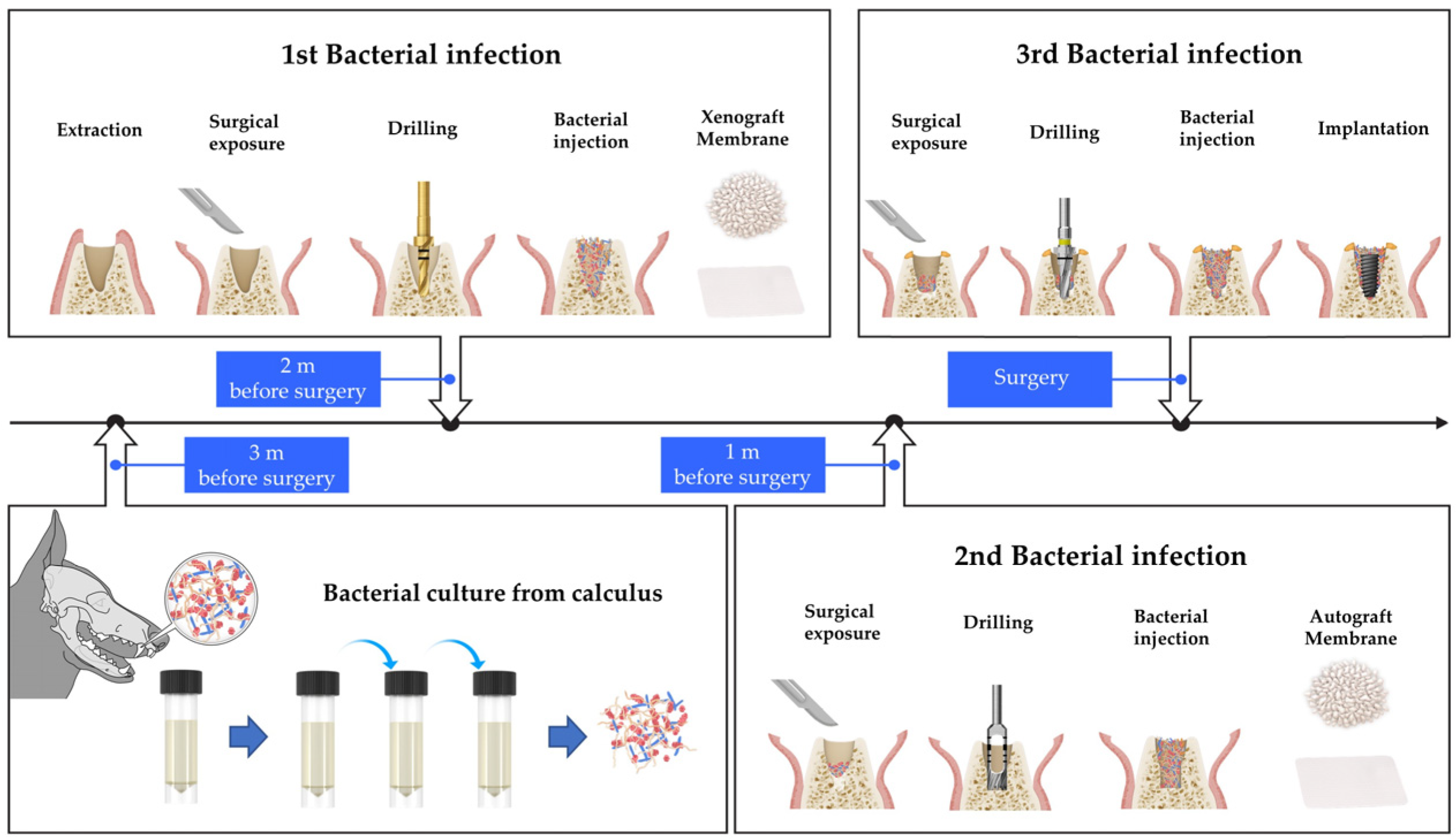
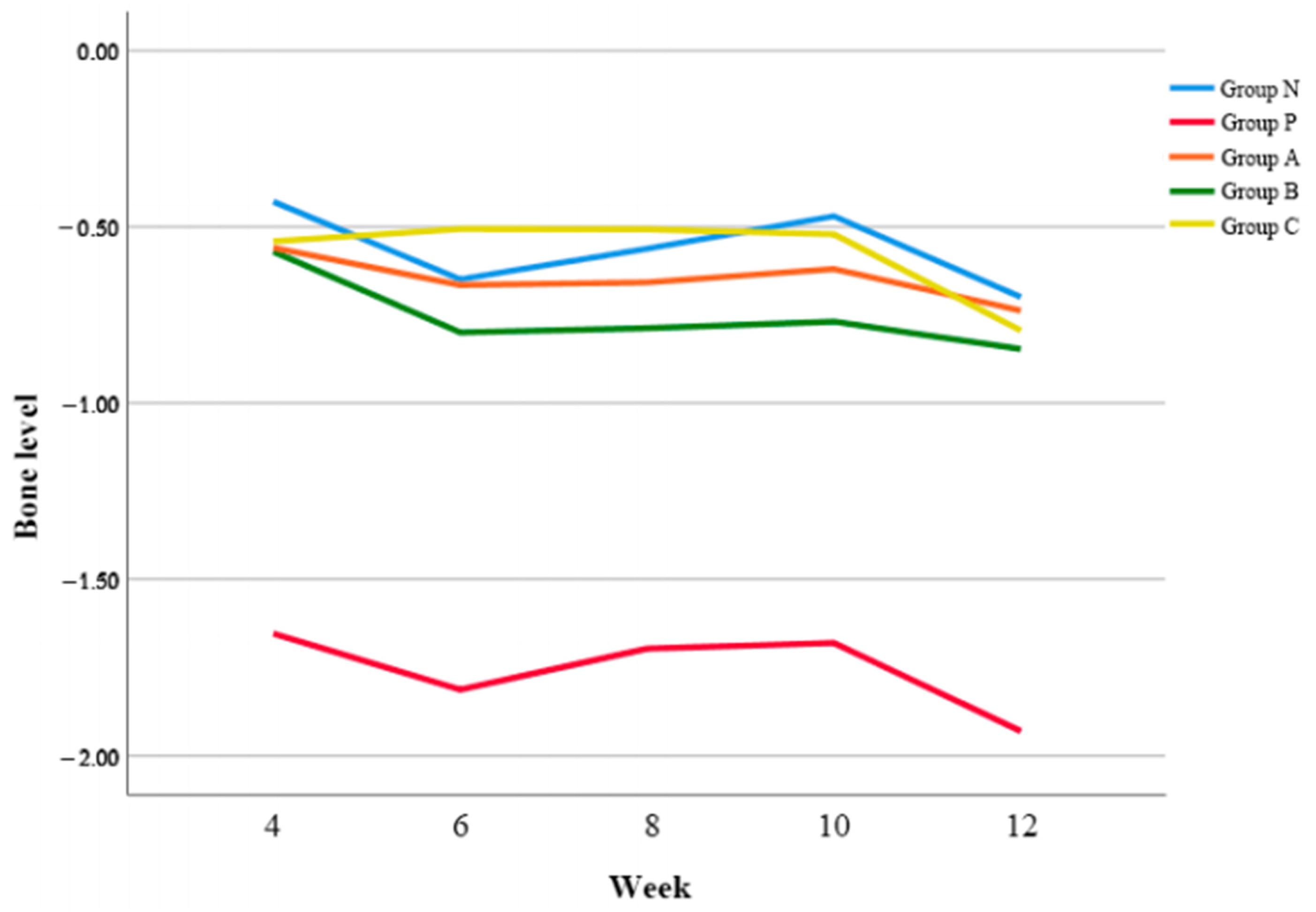
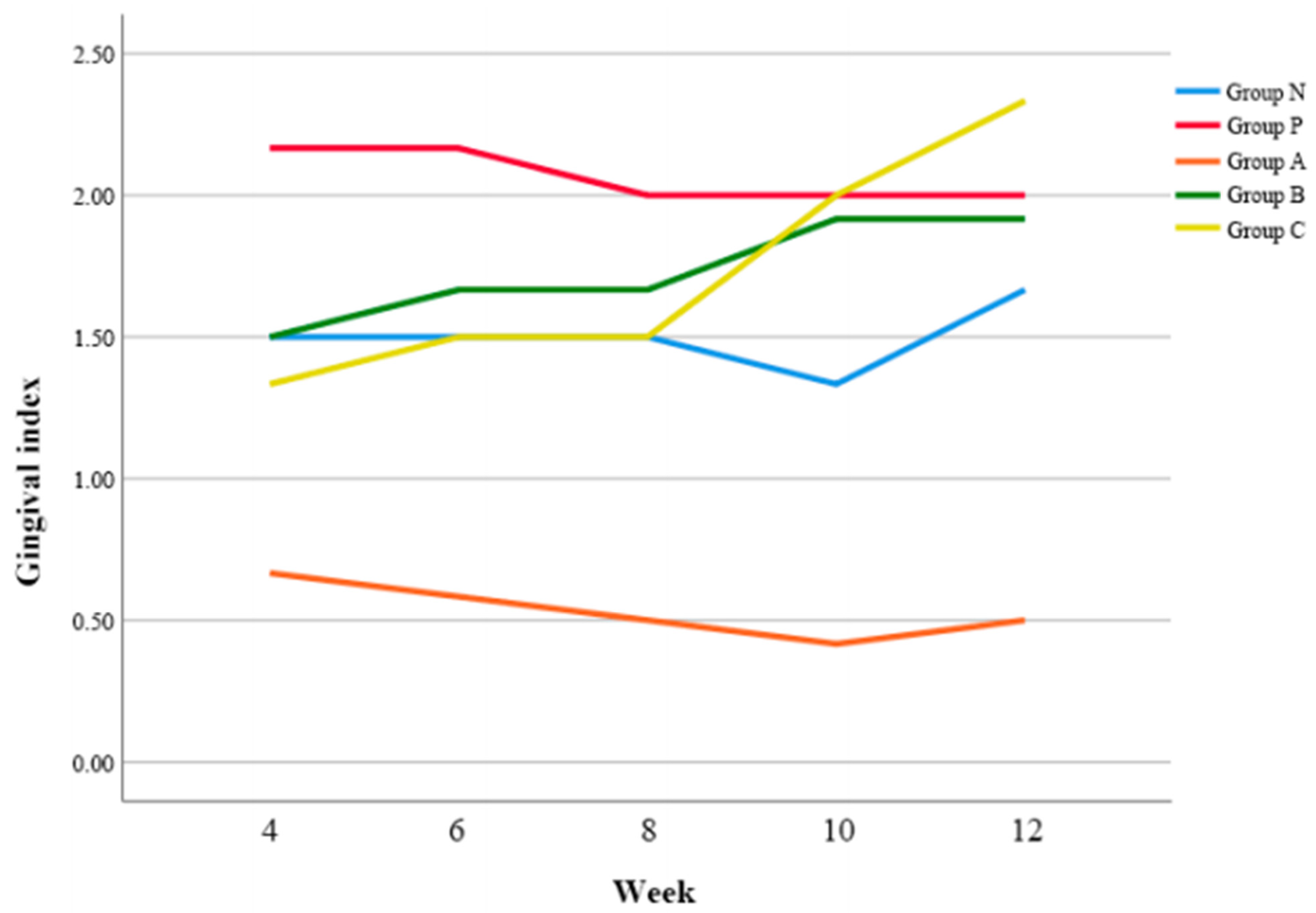
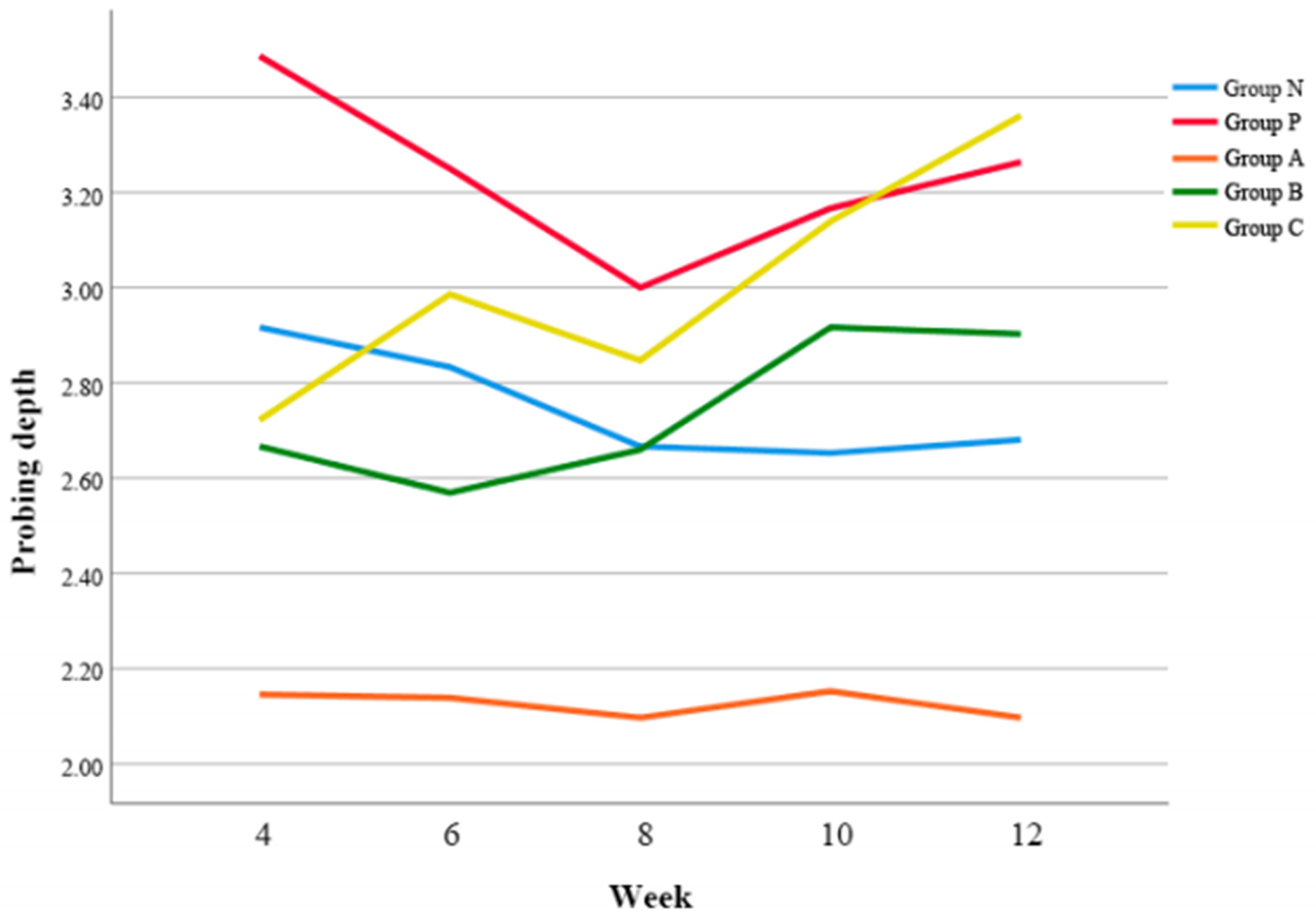
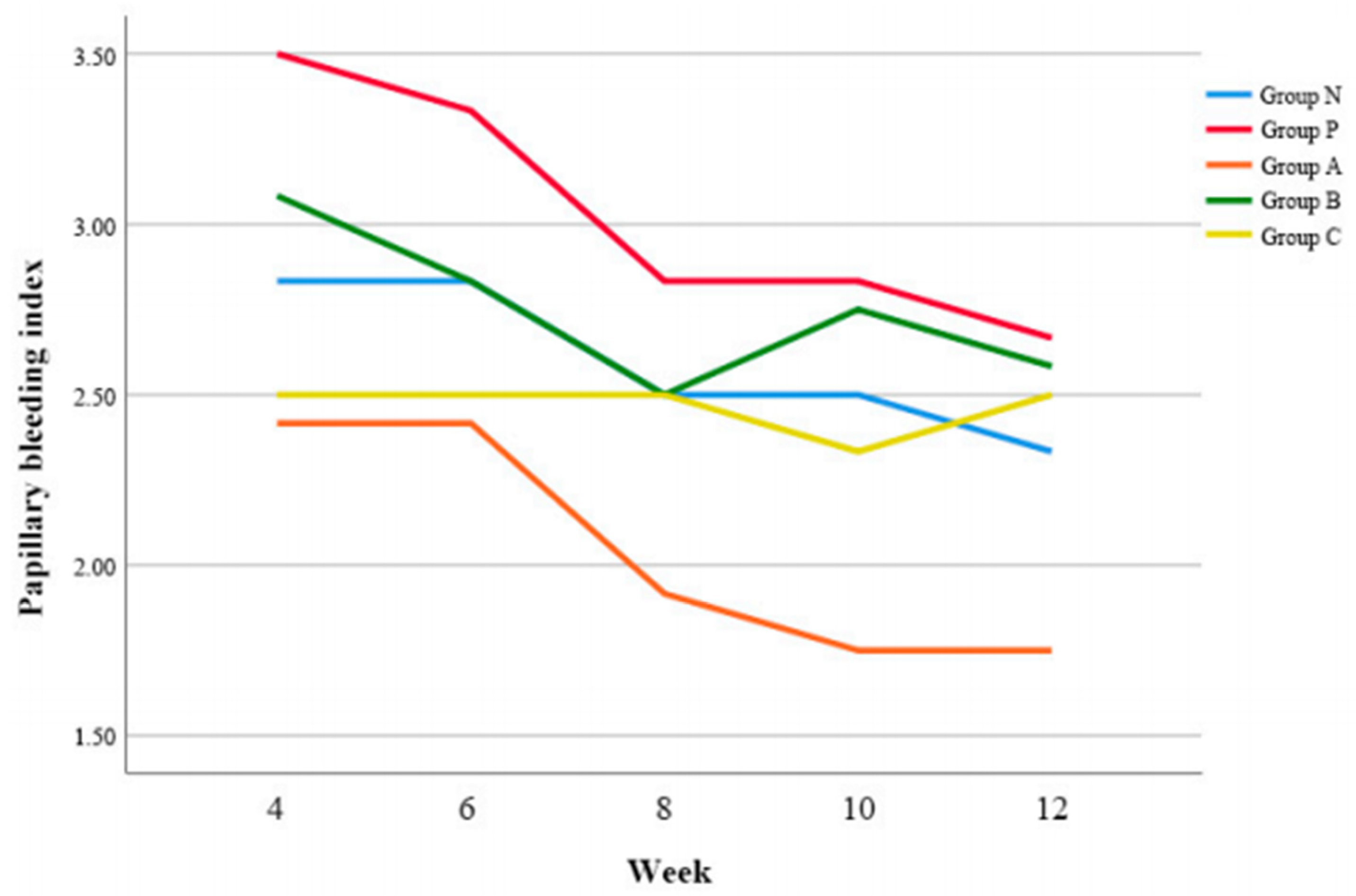

| Scores | Gingival Status | Criteria |
|---|---|---|
| 0 | Absence of inflammation | |
| 1 | Mild inflammation (of any portion) | Slight change in color Little change in texture |
| 2 | Mild inflammation (of the entire gingiva) | Slight change in color Little change in texture |
| 3 | Moderate inflammation | Moderate glazing, redness Edema and/or enlargement of the gingival unit Marked redness |
4 | Severe inflammation | Edema and/or enlargement of the gingival unit Spontaneous bleeding, congestion Ulceration |
| Normal | Slight (Mild) | Moderate | Severe (Advanced) | |
|---|---|---|---|---|
| PD | <3 mm | ≥3 mm and <5 mm | ≥5 mm and <7 mm | ≥7 mm |
| Scores | Criteria |
|---|---|
| 0 | No bleeding |
| 1 | A single discrete bleeding point |
| 2 | Several isolated bleeding points or a single line of blood appears |
| 3 | The interdental triangle fills with blood shortly after probing |
| 4 | Profuse bleeding occurs after probing Blood flows immediately into the marginal sulcus |
| Week | Group N | Group P | Group A | Group B | Group C | p |
|---|---|---|---|---|---|---|
| 12 | 166.0 ± 9.8 | 89.2 ± 63.5 | 155.9 ± 18.6 | 125.3 ± 35.8 | 94.7 ± 15.0 | 0.000 |
| Week | Group | p | ||||
|---|---|---|---|---|---|---|
| N | P | A | B | C | ||
| 4 | 1.5 ± 0.8 | 2.2 ± 0.8 | 0.7 ± 0.8 | 1.5 ± 0.8 | 1.3 ± 1.2 | 0.003 |
| 6 | 1.5 ± 0.9 | 2.2 ± 0.8 | 0.6 ± 0.7 | 1.7 ± 0.7 | 1.5 ± 1.2 | |
| 8 | 1.5 ± 0.8 | 2.0 ± 1.3 | 0.5 ± 1.0 | 1.7 ± 1.0 | 1.5 ± 1.2 | |
| 10 | 1.3 ± 1.0 | 2.0 ± 1.5 | 0.4 ± 1.1 | 1.9 ± 1.2 | 2.0 ± 0.6 | |
| 12 | 1.7 ± 1.0 | 2.0 ± 1.3 | 0.5 ± 1.2 | 1.9 ± 1.0 | 2.3 ± 0.8 | |
| Week | Group | p | ||||
|---|---|---|---|---|---|---|
| N | P | A | B | C | ||
| 4 | 2.9 ± 0.2 | 3.5 ± 0.7 | 2.1 ± 0.3 | 2.7 ± 0.3 | 2.7 ± 0.5 | 0.000 |
| 6 | 2.8 ± 0.3 | 3.3 ± 0.4 | 2.1 ± 0.4 | 2.6 ± 0.4 | 3.0 ± 0.5 | |
| 8 | 2.7 ± 0.5 | 3.0 ± 0.7 | 2.1 ± 0.6 | 2.7 ± 0.5 | 2.8 ± 0.4 | |
| 10 | 2.7 ± 0.5 | 3.2 ± 0.8 | 2.2 ± 0.7 | 2.9 ± 0.7 | 3.1 ± 0.6 | |
| 12 | 2.7 ± 0.6 | 3.3 ± 1.0 | 2.1 ± 0.7 | 2.9 ± 0.6 | 3.4 ± 0.6 | |
| Week | Group | p | ||||
|---|---|---|---|---|---|---|
| N | P | A | B | C | ||
| 4 | 2.8 ± 0.4 | 3.5 ± 0.5 | 2.4 ± 0.7 | 3.1 ± 0.8 | 2.5 ± 0.5 | 0.000 |
| 6 | 2.8 ± 0.8 | 3.3 ± 0.5 | 2.4 ± 0.5 | 2.8 ± 0.6 | 2.5 ± 0.8 | |
| 8 | 2.5 ± 0.5 | 2.8 ± 0.8 | 1.9 ± 0.5 | 2.5 ± 0.5 | 2.5 ± 0.5 | |
| 10 | 2.5 ± 0.5 | 2.8 ± 0.4 | 1.8 ± 0.5 | 2.8 ± 0.5 | 2.3 ± 0.8 | |
| 12 | 2.3 ± 0.8 | 2.7 ± 0.8 | 1.8 ± 0.5 | 2.6 ± 0.5 | 2.5 ± 0.5 | |
Disclaimer/Publisher’s Note: The statements, opinions and data contained in all publications are solely those of the individual author(s) and contributor(s) and not of MDPI and/or the editor(s). MDPI and/or the editor(s) disclaim responsibility for any injury to people or property resulting from any ideas, methods, instructions or products referred to in the content. |
© 2023 by the authors. Licensee MDPI, Basel, Switzerland. This article is an open access article distributed under the terms and conditions of the Creative Commons Attribution (CC BY) license (https://creativecommons.org/licenses/by/4.0/).
Share and Cite
Lee, W.-W.; Seo, J.-W.; Jang, I.-S.; Kwon, Y.-J.; Joung, W.-J.; Jun, J.-H.; Kim, J.; Son, D.; Lim, S.-W.; Yun, S.-H.; et al. Comparison of Prophylactic Effects between Localized Biomimetic Minocycline and Systematic Amoxicillin on Implants Placed Immediately in Infected Sockets. Biomimetics 2023, 8, 461. https://doi.org/10.3390/biomimetics8060461
Lee W-W, Seo J-W, Jang I-S, Kwon Y-J, Joung W-J, Jun J-H, Kim J, Son D, Lim S-W, Yun S-H, et al. Comparison of Prophylactic Effects between Localized Biomimetic Minocycline and Systematic Amoxicillin on Implants Placed Immediately in Infected Sockets. Biomimetics. 2023; 8(6):461. https://doi.org/10.3390/biomimetics8060461
Chicago/Turabian StyleLee, Won-Woo, Jin-Won Seo, Il-Seok Jang, Young-Joong Kwon, Won-Jun Joung, Jong-Hun Jun, Jiyeong Kim, Donghee Son, Seung-Weon Lim, Seo-Hyoung Yun, and et al. 2023. "Comparison of Prophylactic Effects between Localized Biomimetic Minocycline and Systematic Amoxicillin on Implants Placed Immediately in Infected Sockets" Biomimetics 8, no. 6: 461. https://doi.org/10.3390/biomimetics8060461
APA StyleLee, W.-W., Seo, J.-W., Jang, I.-S., Kwon, Y.-J., Joung, W.-J., Jun, J.-H., Kim, J., Son, D., Lim, S.-W., Yun, S.-H., Tallarico, M., & Park, C.-J. (2023). Comparison of Prophylactic Effects between Localized Biomimetic Minocycline and Systematic Amoxicillin on Implants Placed Immediately in Infected Sockets. Biomimetics, 8(6), 461. https://doi.org/10.3390/biomimetics8060461








